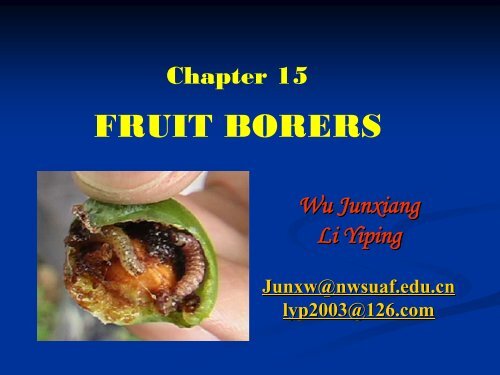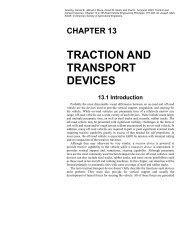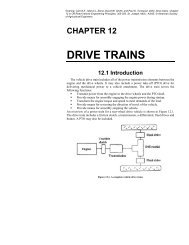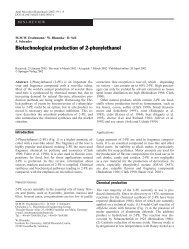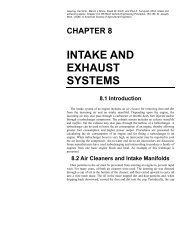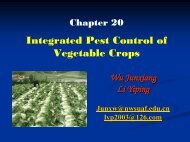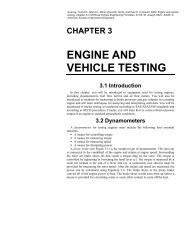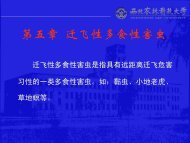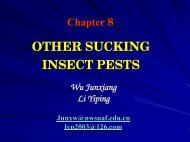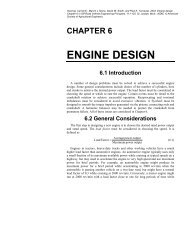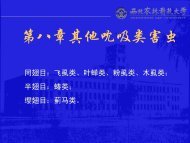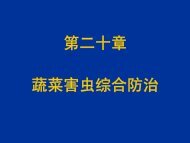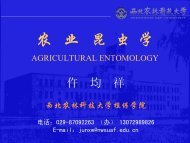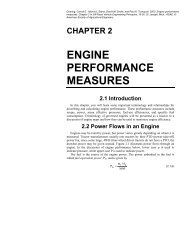FRUIT BORERS
FRUIT BORERS
FRUIT BORERS
You also want an ePaper? Increase the reach of your titles
YUMPU automatically turns print PDFs into web optimized ePapers that Google loves.
Chapter 15<br />
<strong>FRUIT</strong> <strong>BORERS</strong><br />
Wu Junxiang<br />
Li Yiping<br />
Junxw@nwsuaf.edu.cn<br />
lyp2003@126.com
Chapter 15 Fruit Borers<br />
Lecture Outline<br />
Wheat blossom midges<br />
Cotton boll borer and Oriental Tobacco<br />
Budworm<br />
Soybean borers<br />
Fresh fruit borers<br />
Dried fruit borers<br />
Monitoring and Management
Wheat Blossom Midges<br />
( 小 麦 吸 浆 虫 )<br />
Wheat blossom midges = wheat midges<br />
Diptera, Cecidomiidae<br />
• Orange wheat blossom midge<br />
Sitodiplosis mosellana<br />
• Contarinia tritici
Orange wheat blossom midge<br />
Sitodiplosis mosellana
Contarinia tritici
1. Distribution<br />
‣ Cosmopolitan pests, distributed in Asia,<br />
Europe and North America;<br />
‣ Sitodiplosis mosellana favors warm<br />
environment. Mainly occur in wheat<br />
growing areas of valleys of Yellow River and<br />
Huai River in 31-35°N. in China.<br />
‣ Contarinia tritici prefers cool environment.<br />
Mainly distributed in wheat growing areas<br />
of alp and altiplano.
Oligophagous pests. Severely damage wheat, barley,<br />
highland barley wild oat ( 青 稞 ), rey, oat and some<br />
weeds;<br />
2. Damage<br />
Larvae damage to wheat flowers and sucking of the<br />
sap of milking wheat kernels causes wheat plants to<br />
produce non-rich grains. Generally, the amount of<br />
damage is abundant. When severe damage occurs, the<br />
loss is almost 100%.<br />
幼 虫 危 害 小 麦 花 器 和 吸 食 正 在 灌 浆 的 小 麦 籽 粒 的 浆 液 , 造 成 瘪 粒 而<br />
减 产 , 受 害 严 重 时 几 乎 毁 产 。
Sitodiplosis mosellana
Taken by Junxiang Wu in Xushui, Hebei , 2003
Taken by Junxiang Wu in Xushui, Hebei , 2003
3. Life Cycle<br />
1 generation/year;<br />
Overwinter and oversummer as grown<br />
larvae with round cocoon in soil;<br />
Diapause larvae can prolong diapause<br />
for a long time. Longest prolonged time is<br />
more than 7 years, even 12 years to<br />
Sitodiplosis mosellana or less than 4-5<br />
years to Contarinia tritici.
Life Cycle of wheat midges
3. Life Cycle<br />
A close relationship occurs between the<br />
stages of the wheat midge and development of<br />
wheat found in valley areas of Yellew River<br />
and Huai River:<br />
Overwintered larvae come out from cocoon<br />
to surface of soil during shooting stage of<br />
wheat;<br />
Larvae pupate when wheat enters booting<br />
stage;
3. Life Cycle<br />
Adults largely emerge and oviposit during<br />
heading stage.<br />
Peak of egg hatching is concurrent with<br />
blossoming and grouting stage of wheat;<br />
Larvae become grown and leave wheat<br />
heads to drop into soil to oversummer and<br />
overwinter with round cocoons when wheat<br />
become mature.
4. Behaviors<br />
Adults fear strong light and high temp,<br />
so most frequent activity in early morning<br />
and nightfall;<br />
Eggs lay on wheat heads individually;<br />
adults prefer to choose heads without<br />
blossoms to oviposit; very few eggs found<br />
on blossomed heads;<br />
Newly hatched larvae intrude from gap<br />
between inner glume and outer glume to<br />
suck sap of grouting kernels
5. Environmental Factors<br />
1) Climate conditions<br />
Rainfall or soil humidity is the most<br />
important factor influencing population #.
5. Environmental Factors<br />
2) Varieties and developmental stages of wheat<br />
Generally, an obvious insect resistance is found<br />
in wheat varieties with long awns, abundant hairs,<br />
upright stems, densely-ranked spikelets and hard<br />
glumes. Conversely, it is in a contrary manner.<br />
More damage is caused when the wheat heading<br />
stage coincides with the adult stage of wheat blossom<br />
midge. If these stages do not coincide, only a slight<br />
injury appears.<br />
一 般 地 , 芒 长 多 刺 、 挺 直 、 小 穗 排 列 紧 密 、 颖 壳 厚 、 的 品 种 具 有 明<br />
显 的 抗 虫 性 。<br />
若 小 麦 抽 穗 后 尚 未 扬 花 前 的 时 期 与 麦 红 吸 浆 虫 成 虫 盛 发 期 相 吻 合 ,<br />
则 受 害 重 , 反 之 受 害 就 轻 。
5. Environmental Factors<br />
3) Rotation and culture<br />
4) Soil and topography<br />
5) Natural enemies<br />
宽 腹 姬 小 蜂 : parasite rate 75% or more;<br />
Predators: ants, spiders, ladybird<br />
beedles and insect-eating<br />
eating thrips, , etc.
Cotton Bollworm &<br />
Oriental Tobacco Budworm<br />
Cotton Bollworm Helicoverpa armigera<br />
(called also 棉 实 夜 蛾 );<br />
Oriental Tobacco Budworm Helicoverpa<br />
assulta ( 烟 青 虫 , called also 烟 夜 蛾 );<br />
Lepidoptera, Noctuidae
Cotton Bollworm Helicoverpa armigera
Oriental Tobacco Budworm<br />
Helicoverpa assulta
1. Distribution<br />
Cotton Bollworm Helicoverpa armigera:<br />
Asia, Oceania, Africa and Europe;<br />
range from 50°N. to 50°S.;<br />
Nationwide distribution in China;<br />
Constant pest in Northern cotton growing<br />
areas; occasional pest in southern cotton<br />
growing areas;
Oriental Tobacco Budworm<br />
Helicoverpa assulta :<br />
‣ Asia, Oceania;<br />
‣ Nationwide distribution in China; Most<br />
severe damages in tobacco growing areas<br />
along valleys of Yellow River and Huai<br />
River<br />
1. Distribution
Tuvalu, 1991<br />
( 图 瓦 卢 —— 西 太 平 洋 岛 国 )
2. Damage<br />
Cotton bollworm is a polyphagous pest.<br />
More than 200 host plants in 30 families<br />
recorded. Cotton, tomato and corn severely<br />
damaged;<br />
Oriental tobacco budworm is an<br />
oligophagous pest, only feed on tobacco,<br />
pepper, etc.
2. Damage<br />
The larvae initially feed on the leaves<br />
and then bore into the square/bolls and<br />
seeds, thrusting their heads into the bolls<br />
and leaving the rest of their bodies outside.<br />
The entry holes are large and circular at<br />
the base of the boll. One larva can damage<br />
about 10 square/bolls in a lifetime,<br />
maximum 18.
3. Life Cycle<br />
3-7 generations per year; 3 in Liao River<br />
and Xinjiang, 2nd causing the most damage;<br />
4 in Yellow River and part of Yangtsz River,<br />
2nd causing the most damage, next 3rd; 5 in<br />
most of Yangtsz River, 3rd and 4th causing<br />
the most damage; 6-7 in areas south of<br />
25°N., 3 rd , 4 th and 5th causing severe<br />
damage.<br />
Overwinter as pupa in soil-cells under<br />
ground
3. Life Cycle<br />
In cotton growing area of Yellow River<br />
valley, adults of overwintered generation<br />
appear in late April to early May. Larvae of<br />
1st generation mainly feed on wheat, peas,<br />
alfalfa, spring corn and tomatoes, etc.; enter<br />
soil to pupate in early-mid Jun. A large<br />
amount of 1st generation adults appear in<br />
mid-late Jun., which is the square stage of<br />
cotton. Larvae of 2nd generation cause the<br />
most severe damage to cotton.
3. Life History<br />
Adults of 2 nd generation appear<br />
copiously from late Jul. to early Aug. Most<br />
oviposit on cotton; a few move to tomato or<br />
corn fields to oviposit. Third generation<br />
adults appear from late Aug. to early Sep.<br />
Most of them lay eggs on cotton; some lay<br />
eggs on summer corn, tomatoes, peppers and<br />
sorghum. Larvae of 4th generation mature<br />
from late Sep. to early Oct. and enter soil of<br />
5-15cm depth to overwinter.
4. Main habits<br />
Adults:<br />
Are still in shadows during daytime; are<br />
active in nightfall and night;<br />
Strong tropism to nectar, light and poplar<br />
branches;<br />
Lay eggs individually on tender tips and<br />
leaves of plants that are growing well<br />
and have many squares.
4. Main habits<br />
Larvae:<br />
Newly hatched larvae feed on growing<br />
points and young leaves; 2nd instar larvae<br />
feed on squares; 3 rd to 6 th instar larvae feed<br />
on green bolls in addition to squares and<br />
flowers;<br />
Often move between plants;<br />
Cannibalism in 3rd instar larvae or older;<br />
Grown larvae<br />
pupate in soil-cells
4. Factors Influencing Population<br />
Optimal temp.25-28℃, RH 70%+;<br />
Multi-planting system is favorable<br />
for cotton bollworm;<br />
B.t cotton;<br />
Natural enemies.
Soybean Borers<br />
( 豆 类 食 心 虫 )<br />
Soybean borers feed on flowers and<br />
pods of soybean during late growing.<br />
• Soybean pod borer Leguminivora<br />
glycinivorella ( 大 豆 食 心 虫 )<br />
• Limabean pod borer Etiella zinckenella<br />
( 豆 荚 螟 )<br />
• Legume pod borer Maruca testulalis ( 豆<br />
野 螟 )
1. Soybean Pod Borer<br />
Leguminivora glycinivorella<br />
( 大 豆 食 心 虫 )<br />
Called also 大 豆 蛀 荚<br />
蛾 , 小 红 虫 , 豆 荚 虫 ;<br />
Lepidoptera;<br />
Olethreutidae<br />
( 小 卷 蛾 科 )
2. Limabean pod borer<br />
Etiella zinckenella<br />
( 豆 荚 螟 )<br />
Called also 豆 蛀 虫 ;<br />
Lepidoptera;<br />
Pyralidae.
3. Legume pod borer<br />
Maruca testulalis<br />
( 豆 野 螟 )<br />
‣ Chinese byname is<br />
大 豆 卷 叶 螟 , 豇 豆<br />
钻 心 虫 and 大 豆 螟<br />
蛾 ;<br />
‣ Lepidoptera;<br />
‣ Pyralidae.
3. Legume pod borer<br />
Maruca testulalis<br />
( 豆 野 螟 )
Borers of Pome and Stone Fruits<br />
( 仁 果 、 核 果 类 食 心 虫 )
1. Common Species<br />
• Peach fruit moth Carposina sasakii ( 桃 蛀 果 蛾 ,<br />
桃 小 食 心 虫 , 简 称 “ 桃 小 ”)<br />
• Yellow peach moth Dichocrocis punctiferalis<br />
( 桃 蛀 野 螟 , 桃 蛀 螟 , 桃 蠹 螟 , 桃 斑 蛀 螟 )<br />
• Craphlitha molesta ( 梨 小 食 心 虫 , 桃 折 梢 虫 , 梨<br />
小 蛀 果 蛾 , 东 方 果 蠹 蛾 , 梨 姬 食 心 虫 , 桃 折 心 虫 ,<br />
简 称 “ 梨 小 ”)
1. Common Species<br />
• Pear fruit moth Myelois pirivorella ( 梨 云 翅 斑<br />
螟 , 梨 大 食 心 虫 , 简 称 “ 梨 大 ”)<br />
• Spilonota albicana ( 白 小 食 心 虫 , 简 称 “ 白 小 ”)<br />
• Grapholitha inopinata ( 苹 小 食 心 虫 , 简 称 “ 苹<br />
小 ”)<br />
• Argyresthia assimilis ( 苹 异 银 蛾 )<br />
• Codling moth Laspeyresia pomonella ( 苹 果 蠹<br />
蛾 )
Peach fruit moth Carposina sasakii
Yellow peach moth<br />
Dichocrocis punctiferalis ( 桃 蛀 野 螟 )
Craphlitha molesta ( 梨 小 食 心 虫 )
Nephopteryx pirivorella ( 梨 云 翅 斑 螟 )
Spilonota albicana ( 白 小 食 心 虫
Grapholitha inopinata ( 苹 小 食 心 虫 )
Argyresthia assimilis ( 苹 异 银 蛾 )
2. Distribution and Damage<br />
Peach fruit moth Carposina sasakii( 桃 蛀 果 蛾 )<br />
Northern fruit growing areas;<br />
Oligophagous pest. Mainly damage apple,<br />
Chinese cherry ( 海 棠 ), pear, apricot,<br />
hawthorn ( 山 楂 ), Chinese date ( 枣 ), spine date<br />
( 酸 枣 ) in Rosaceae( 蔷 薇 科 ) and Rhamnaceae<br />
( 鼠 李 科 ).
2. Distribution and Damage<br />
Apple, Chinese date and hawthorn most<br />
severely damaged.<br />
Needlepoint-like boring holes on the fruit<br />
surface and teardrop-like sap, which becomes<br />
white when dry, are often found outside holes<br />
on damaged apple fruits. Larvae feed inside<br />
fruits causing many zigzagging tunnels and<br />
fill these tunnels with dung. This damage is<br />
called “ 豆 沙 馅 ”.<br />
危 害 苹 果 , 果 面 有 针 尖 大 小 蛀 入 孔 , 孔 外 溢 出 泪 珠 状 汁 液 , 干 涸 呈<br />
白 色 絮 状 物 。 幼 虫 在 果 内 窜 食 , 虫 道 纵 横 弯 曲 , 并 留 有 大 量 虫 粪 , 呈<br />
“ 豆 沙 馅 ” 害 状 。
Peach fruit moth Carposina sasakii damage
Peach fruit moth Carposina sasakii damage
2. Distribution and Damage<br />
2. Yellow peach moth Dichocrocis<br />
punctiferalis ( 桃 蛀 野 螟 )<br />
Nationwide distribution in China. Most<br />
severe damage occurs in peach growing areas<br />
from Hebei to south valley of Yangstz River.<br />
Polyphagous pest; prefer peach, guava ( 石<br />
榴 );<br />
Heavy dung-like granules piled outside<br />
wormhole
Yellow peach moth<br />
Dichocrocis punctiferalis<br />
damage
Craphlitha molesta ( 梨 小 食 心 虫 ) damage
3. Life History and Habits<br />
1) Peach fruit moth Carposina sasakii<br />
1-2 generations/year in most of apple<br />
growing areas;<br />
Overwinter as grown larvae underground<br />
with flat-round cocoons within 1m from<br />
stems;<br />
Overwintered larvae begin to come out<br />
from soil to pupate early-mid May, peak in<br />
late May to early Jun.
3. Life History and Habits<br />
Adults of overwintered generation appear<br />
in succession after late May;<br />
Most eggs lay on fruits individually and<br />
often found near pit of calyces ( 花 萼 );<br />
Larvae of 1st generation become grown<br />
and leave fruit to drop into soil from early<br />
Jul. to early Sep.<br />
Larvae of 2nd generation leave fruits from<br />
mid-late Aug. until Oct., then overwinter.
3. Life Cycle and Habits<br />
2) Yellow peach moth Dichocrocis punctiferalis<br />
2-4 generations/year in North, such as 2 in<br />
Liaoning, 3-4 in Shaanxi;<br />
Overwinter as grown larvae with cocoons in<br />
cracks of warped barks;<br />
Overwintered larvae begin to emerge in mid<br />
May, peak of eclosion in late May<br />
Adult peaks of 1st, 2nd, and 3rd generations<br />
occur in early Jul., early-mid Aug. and early-mid<br />
Sep. respectively.
3. Life Cycle and Habits<br />
Adults fly and mate at night and have stronger<br />
tropism to black light and sugar-vinegar liquor;<br />
Adults of overwintered generation lay most eggs<br />
on fruits of peach, plum ( 李 ) and apricot; other<br />
generations on peach, guava ( 石 榴 ) and chestnut ( 板<br />
栗 );<br />
Final grown larvae transfer and overwinter in<br />
late Sep.
3. Environmental factors<br />
Peach fruit moth Carposina sasakii:<br />
‣ Overwintered larvae come out from soil<br />
to pupate: ground temp. over 20ºC and 10%<br />
water content in soil;<br />
‣ Diapause under both long photoperiod<br />
and short photoperiod;<br />
‣ 金 冠 severely damaged; next 红 元 帅 ; 国<br />
光 and 祝 less.
3. Environmental factors<br />
Yellow peach moth Dichocrocis punctiferalis<br />
Strong adaptability; moth occurs in fruitgrowing<br />
areas of all China.<br />
Lower temp. in winter is a limiting factor.<br />
Death rate of overwinter larvae is about<br />
44.4%-80%, especially more in immature<br />
overwinter larvae.
Dry-fruit Borers<br />
( 干 果 类 害 虫 )<br />
Dry-fruits include persimmon ( 柿 子 ),<br />
Chinese date ( 枣 ), walnut ( 胡 桃 , 核 桃 )、<br />
chestnut ( 板 栗 ), etc.
Common Insect Pests<br />
• Kakivoria flavofasciata ( 柿 蒂 虫 )<br />
• Atrijuglans hetaohei ( 核 桃 举 肢 蛾 )<br />
• Curculio davidi ( 栗 实 象 甲 )
Stathmophora massinisa ( 柿 蒂 虫 )<br />
Called also 柿<br />
实 蛾 or 柿 食 心<br />
虫 ;<br />
Lepidoptera;<br />
Heliodinidae<br />
( 举 肢 蛾 科 )
Atrijuglans hetaohei ( 核 桃 举 肢 蛾 )<br />
又 名 核 桃 黑 ; Lepidoptera; Heliodinidae
Curculio davidi ( 栗 实 象 甲 )<br />
‣ Called also 栗<br />
象 鼻 虫 , 板 栗 象<br />
甲 and 栗 象 ;<br />
‣ Coleoptera;<br />
‣ Curculionidae<br />
( 象 甲 科 )
Monitoring<br />
and<br />
Management
1. Survey Methods<br />
Wheat blossom midges:<br />
Basic number of oversummer and<br />
overwinter population;<br />
Dynamics of larvae development and<br />
pupating in spring;<br />
Adult # during heading stage;<br />
Larvae # on wheat heads.
1. Survey Methods<br />
Cotton bollworm Helicoverpa armigera<br />
Basic number of overwinter pupa;<br />
Adult #;<br />
Number of larvae and eggs;<br />
Number of natural enemies.
1. Survey Methods<br />
Peach fruit moth Carposina sasakii<br />
‣ Number of overwinter larvae;<br />
‣ Overwinter larva dynamics of coming<br />
out from soil in spring;<br />
‣ Adult # and dynamics;<br />
‣ Egg-fruit rate.
2. Control Techniques<br />
1) Wheat blossom midges<br />
In integrated pest management, from a<br />
long-term view, the tactics of wheat blossom<br />
midge control should be to put choosing and<br />
breeding resistant varieties and improving<br />
cultural techniques as basic measures, with<br />
chemical control as an additional measure.<br />
防 治 小 麦 吸 浆 虫 的 策 略 , 从 长 远 考 虑 应 以 选 育 抗 虫 品 种 和 改 进 耕 作<br />
栽 培 技 术 为 基 本 措 施 , 辅 以 必 要 的 化 学 药 剂 防 治 , 实 行 综 合 治 理 。
2. Control Techniques<br />
Cultural control<br />
Rational crop rotation;<br />
Resistant varieties.<br />
Chemical control<br />
Economic threshold: 4.5 million/hm 2<br />
(only reference);<br />
Optimal time: pupating peak and adult<br />
emerging peak.
2. Control Techniques<br />
2) Cotton bollworm Helicoverpa armigera<br />
Cultural control<br />
Deeply plowing and irrigation in winter<br />
to decrease overwinter pupa;<br />
Plant resistant BT cotton;<br />
Biological control<br />
Release trichogrammatids 2-3 times at<br />
the beginning of egg peak.
2. Control Techniques<br />
Trap-killing Adults<br />
Black light;<br />
High pressure mercury light;<br />
Poplar branches;<br />
Sexual lure.<br />
Chemical control<br />
Spray insecticides before 3 rd larvae
2. Control Techniques<br />
To control the cotton boll borer of 2nd generation,<br />
the insecticide solution should first be sprayed on<br />
tender upper leaves and main tips of plants and then<br />
on tender lower leaves and peripheral tips of plants.<br />
This method is called “ 点 点 划 圈 ”. To control the<br />
cotton boll borer of 3rd and 4th generations, first<br />
spray plant peripheral tips and young squares<br />
around plants and then spray the main tips of plants.<br />
This method is called “ 划 圈 点 点 ”.<br />
防 治 2 代 棉 铃 虫 时 , 主 要 喷 洒 在 棉 株 上 部 嫩 叶 和 顶 尖 上 ,“ 点 点 划<br />
圈 ”; 第 3、4 代 要 喷 洒 在 群 尖 和 幼 蕾 上 , 四 周 打 透 ,“ 划 圈 点 点 ” 。
2. Control Techniques<br />
3) Control of fruit borers<br />
Cultural control<br />
Deeply plowing soil in winter;<br />
Plant trapping crops such as sunflower<br />
and cross sorghum to lure adults of yellow<br />
peach borer to oviposit. Spray insecticides<br />
after ending of ovipositing;<br />
Bundle weeds on trunks to trap overwinter<br />
pests.
2. Control Techniques<br />
Biological control<br />
Applying nematode pathogens into soil<br />
can control fruit-borer larvae living<br />
underground. To control larvae having left<br />
fruits, release egg trichogrammatids and<br />
protect parasitoids such as 甲 腹 茧 蜂 and 齿 腿<br />
姬 蜂 or use white muscardine fungi.<br />
将 昆 虫 病 原 线 虫 施 入 土 壤 , 可 控 制 地 下 阶 段 生 活 的 蛀 果 害 虫 。 释 放<br />
赤 眼 卵 蜂 , 保 护 甲 腹 茧 蜂 、 齿 腿 姬 蜂 等 寄 生 蜂 , 利 用 白 僵 菌 防 治 脱 果 幼<br />
虫 等 。
2. Control Techniques<br />
Physical control<br />
Black light trapping;<br />
Sugar-vinegar liquor<br />
trapping;<br />
Sexual lure.<br />
Cover-bag on fruits<br />
Extirpate fruits with<br />
borers in time;<br />
Scratch old and warped<br />
bark
2. Control Techniques<br />
Chemical control<br />
Key time to spray insecticides:<br />
Moth peaks;<br />
Egg hatching peaks.<br />
Economic threshold:
Lepidopteran larvae consume<br />
1/6 of the world's daily agricultural<br />
production.<br />
Cited from<br />
http://www.cns.fr/externe/English/Projets/Projet_NK/organ<br />
isme_NK.html


